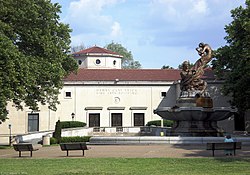Frick Fine Arts Building (University of Pittsburgh)
|
Henry Clay Frick Fine Arts Building
|
|

The Frick Fine Arts Building at the University of Pittsburgh sits behind the Schenley Fountain
|
|
| Coordinates | 40°26′30.11″N 79°57′4.50″W / 40.4416972°N 79.9512500°WCoordinates: 40°26′30.11″N 79°57′4.50″W / 40.4416972°N 79.9512500°W |
|---|---|
| Built | 1962–1965 |
| Architect | Burton Kenneth Johnstone |
| Architectural style | Neo-Renaissance |
| Part of | Schenley Farms Historic District (#83002213) |
| Added to NRHP | July 22, 1983 |
The Henry Clay Frick Fine Arts Building is a landmark Renaissance villa and a contributing property to the Schenley Farms-Oakland Civic Historic District on the campus of the University of Pittsburgh in Pittsburgh, Pennsylvania, United States. The Frick Fine Arts Building sits on the southern edge of Schenley Plaza, opposite The Carnegie Institute, and is the home of Pitt’s History of Art and Architecture Department, Studio Arts Department, and the Frick Fine Arts Library. Before its front steps is Mary Schenley Memorial Fountain.
The Frick Fine Arts Building sits on the site of the former Schenley Park Casino, Pittsburgh's first multi-purpose arena with an indoor ice skating rink, sat on the location of the building before burning down in December 1896.
The building itself is a gift of Helen Clay Frick (1888–1984), daughter of the Pittsburgh industrialist and art patron Henry Clay Frick (1849–1919). She established the Fine Arts Department at the University of Pittsburgh in 1926 and continued to fund it through the 1950s, when she first made a commitment to create a separate structure to house it. Land for the project was donated to the university by the City of Pittsburgh.
In early negotiations with the University of Pittsburgh, Miss Frick asked that successors to the New York architects Carrère and Hastings design the new facility after the Italian palazzo its firm had built in Manhattan for her father some fifty years earlier. Eventually, however, both parties agreed to Burton Kenneth Johnstone Associates as the architects. Its design is modeled after Pope Julius III's (1487–1555) Villa Giulia in Rome, Italy. The building is constructed of white limestone and marble with a terracotta tile roof around a central courtyard. An octagonal cupola, which caps the central rotunda, rises 45 feet above the ground. The building houses the University of Pittsburgh's Department of History of Art and Architecture, and contains classrooms, an open cloister, an art gallery, a 200-seat auditorium, as well as a research library. Construction began in 1962 and the building was opened in May 1965.
...
Wikipedia
